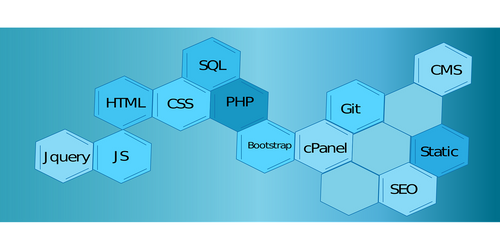What is a Software Development Process?
Nowadays, if you want to buy software, you can use a ready-made product or build an application from scratch. Although the first solution is quick and convenient, the second one gives you more options. The main feature of such a product is that it is created specifically for the buyer's requirements, the customer decides about the software's functionality and appearance. What is more, there are experts who gather all the requirements and guidelines from the customer and based on this information are able to advise what such software should contain. Software development processes aim to deliver a system that fully meets the customer's expectations, within the agreed time and budget.
Software development is a complex process consisting of several stages. Certain activities are necessary to be performed in order to create and maintain a properly functioning system. This process is also known as the software life cycle.
What are Phases of the Software Development Life Cycle (SDLC)?
The Software Development Life Cycle is a transparent process used in the IT industry to design and build software. More precisely, it is a complete software development process with various stages and steps from idea to construction, implementation and maintenance. It is divided into several phases, ideally from five to eight. Depending on how you work, these elements can be configured accordingly. From a business point of view, each stage of the software development process is very important because it affects the final result and customer satisfaction with the product.

-
Planning & analysis - The first phase in the software development process is gathering the information from the client and analysis of each element of the project. In order to build a successful product, you need to determine the scope of work and functionalities which need to be implemented. You have to choose the right strategy and think about the end users of the application, i.e. who they are, what are their expectations regarding the product, etc. It is worth knowing what problem the product is supposed to solve or what exactly it is supposed to deliver. It is important to think about how to meet the needs of the users. At this stage, it is often possible to decide which IT specialists are necessary to carry out the project and to estimate the budget.
-
Design - This stage involves planning a visual part of the project with help of UX and UI designers do. They carefully outline the way the application will run, work out the intuitiveness of navigation, as well as design the layout. Seemingly less important, but attention to design is one of the components of success. The engaging appearance and easy operation of the application attracts customers. It is possible to use ready-made templates that can later be adapted and customized. You can also make a dedicated design; it all depends on the project and the target group. When creating the interface, you have to be very precise and pay attention to every detail. The mistakes are almost immediately noticeable to the user. It is important to remember that the application must not only be visually appealing but also, and probably above all, functional.
-
Development - Having gathered the information from the previous stages, the software development process can finally start. The whole team starts working together under the supervision of the Project Manager, whose task is to monitor the work progress. Initially, programmers create a software architecture, which is a framework on which everything is built. Design also includes representing the data flow and communication of the product with external modules. Also, the internal design of the modules must be clearly defined in all details. When the design document is ready, the development team starts writing the source code. This stage takes place when all software components are created and assembled. This is the longest phase of the cycle during which the actual product is built. The end result is functioning software and documented source code.
-
Testing - One of tasks during the development process is running tests to catch any errors as soon as possible. Checking the functionality of the code and finding mistakes in it is an important part of creating a high-quality application. Testers check the software to evaluate its components and modules after coding. The software consists of various elements, therefore it requires various types of software tests to be run on it. Testers evaluate functionality and performance. They also check for errors using functional and non-functional tests. Testing can be performed manually or automatically. Detected problems are reported and fixed by software developers.
-
Deployment - After testing the application and fixing errors, you can go on to the deployment phase. Often, at the beginning, a new product is additionally subjected to acceptance testing, which is performed by the client and developers. After checking and collecting feedback, a team of IT specialists considers the necessary changes to improve the software. When final touches are completed, the product can be released to the end-user target market.
-
Maintenance - The work on your product does not end when the complete application is delivered to the client. Such software will still need ongoing checking, updating and maintenance to keep it running well. To meet ever-changing user demands and ensure security, new and improved features must be constantly developed, and security updates need to be implemented regularly. All this is necessary for users to be satisfied with the purchased product.
What Software Development Process Models Do We Have?

The software development process is complex and involves much more than just technical knowledge. To facilitate the work, development teams have a large number of types of software development process models to choose from. They breakdown the project tasks into manageable phases and sequence the process.
Waterfall Model
One of the most popular models is the Waterfall Model. In this approach each subsequent stage of work follows the completion of the previous one. This makes it one of the most effective models. This approach allows you to quickly review the development process from start to finish and adjust steps as you go along. The waterfall method is suitable for simple software development projects that are unlikely to undergo significant changes during development. The team, on the other hand, is able to easily understand each parameter and can efficiently navigate through the product development phases.
Incremental build model
Incremental build model is the process of dividing development phases into different sections based on user feedback. In this method, the team develops one piece of software step by step and puts it through user testing for feedback before moving on to the next phase of the process. This allows for early error detection and compliance with the parameters required by the client. In this model, the team must work closely with the client to know their expectations in detail. This model is suitable for more complex projects where frequent usability testing is necessary.
##Iterative model Iterative model aims to develop the system by creating small parts of all functions at once. This allows you to quickly reach the initial scope of the project, share it and get the first feedback. This model starts with the implementation of a small range of software requirements. They are then iteratively improved in developing versions until the system is complete. This approach starts with a piece of software that is deployed and reviewed to identify further requirements. In this method, you can quickly see results in the early stages of work, which makes it easy to identify and fix all defects. The iterative model is suitable for large software that can be easily divided into modules.
SDLC Benefits

SDLC is of great importance to the project because it brings measurable benefits. A properly executed software life cycle can provide teams with the highest level of work. IT professionals are more efficient because they are up to speed with what they should be creating and why. The parties agree on a goal from the beginning and develop a clear action plan to achieve the goal.
Use of this process allows to:
- provide a structure for planning and scheduling the project;
- define the direction of action and the scope of work;
- establish all steps related to each phase of the project;
- accelerate the development process while maintaining its precision;
- more easily estimate costs and time for implementation;
- reduce the occurrence of errors;
- streamline the entire software development process;
- strengthen customer relationships by regular contacts.
How Vratislavia Software Can Help your Company?

If you need software, Vratislavia Software is happy to build it for you. You can count on us at every stage of work, and you will have access to progress at every stage of software development.
Many years of programming practice and the experience we have gained during this time help us write code which is transparent and easy to modify in the future. In addition, we work hard to minimize the risk of errors occurrence because software developers and testers perform system tests on an ongoing basis.
We are a small software house, therefore every client is important to us, and we are fully involved in every project. We employ only middle and senior level engineers who willingly share their knowledge and experience with our customers. You can always count on our support. If you want to learn more about how we work, you can arrange a free consultation with our representative.



